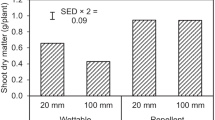Abstract
The rates of emergence of wheat and lupin were measured in 13 field experiments on water repellent sands. Conventional sowing was compared with furrow sowing either with or without the use of a press wheel and several rates of banded wetting agent. Measurements included, severity of water repellence, plant emergence, rainfall, soil temperature at sowing and, at one site, the area of wet soil after sowing. All ameliorative techniques improved emergence, with responses being greatest when seeds were sown into dry soil. Compared with conventional sowing, furrow sowing increased wheat and lupin emergence by an overall average of 16 and 41%, respectively. The benefits were greater at the drier sites. Increases in emergence due to the use of a press wheel were sometimes small, although they always occurred (1–19%). It was visually observed that press wheel use gave more uniform seeding depth, reduced clods and ensured more accurate placement of banded wetting agent. Banded wetting agent consistently improved wheat and lupin emergence, particularly where early rains were light and press wheels were used. The wetting agent increased the cross-sectional area of wet topsoil (0–10 cm) which was positively related with increased wheat emergence (R2 = 0.91). At 0.5 L ha−1 of banded wetting agent, the soil along the furrow was four times wetter than without wetting agent. Wetting agent at 0.5 and 1 L ha−1 (with press wheels) increased wheat emergence by 6 and 11% and lupin emergence by 13 and 11%, respectively. The high rates of banded wetting agent gave highest plant densities. Grain yield was only measured at three sites. Furrow sowing did not increase grain yield, however, press wheels use with furrow sowing increased grain yield by 30%. Banded wetting agent increased grain yield and they were positively correlated. The highest rate increased grain yields by a further 9% above press wheels and furrow sowing.
Similar content being viewed by others
References
Bond R D 1972 Germination and yield of barley when grown in a water repellent sand. Agron. J. 64, 402–403.
Crabtree W L and Gilkes R J 1999a Banded wetting agent and compaction improves barley production on a water repellent sand. Agron. J. 91, 463–467.
Crabtree W L and Gilkes R J 1999b Improved pasture establishment and production on water repellent sandy soils. Agron. J. 91, 467–470.
Ritsema C J and Drekker L W 1994 How water moves in a water repellent sandy soil. Amer. Geophys. Union 30, 2519–2531.
Hyder D N, Sneva F A and Sawyer W A 1955 Soil firming may improve range seeding operations. J. Range Manage. 8, 159–163.
King P M 1981 Comparisons of methods for measuring severity of water repellence on sandy soils and assessment of some factors that affect its measurement. Aust. J. of Soil Res. 19, 275–285.
King P M 1985 Management of sandy soils. Proc. Jerramungup Soil Conservation District Advisory Committee Seminar. ‘Lucerne Logic’, Western Australia, 5 March. pp 18–23.
McGhie D A 1983 Water repellent soils on farms. Western Australian Department of Agriculture. Farmnote 117/83.
Northcote K H 1979 A Factual Key for the Recognition of Australian Soils. Rellim Technical Publications, Glenside, South Australia.
Stout B A, Buchele W F and Snyder F W 1961 Effect of soil compaction on seedling emergence under simulated field conditions. Agric. Engrg. 42, 68–87.
Wetherby K G 1984 The extent and significance of water repellent sands on Eyre Peninsula. Dept. of Agric. South Australia Technical Report 47.
Author information
Authors and Affiliations
Rights and permissions
About this article
Cite this article
Crabtree, W.L., Henderson, C.W.L. Furrows, press wheels and wetting agents improve crop emergence and yield on water repellent soils. Plant and Soil 214, 1–8 (1999). https://doi.org/10.1023/A:1004314427626
Issue Date:
DOI: https://doi.org/10.1023/A:1004314427626




